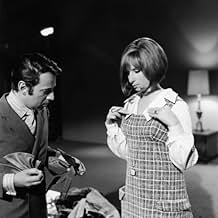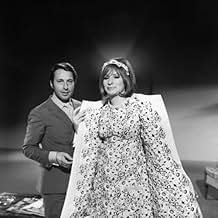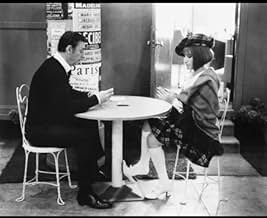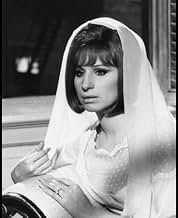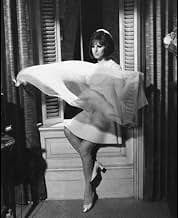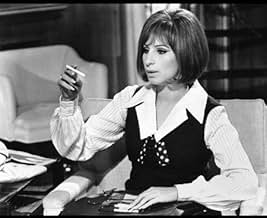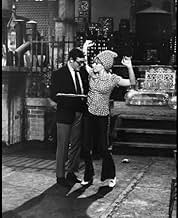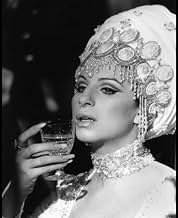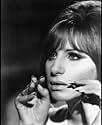Una joven con problemas, que consulta a un psicoterapeuta para que la ayude a dejar de fumar, se somete a hipnosis y se encuentra reviviendo una trágica aventura amorosa victoriana en una vi... Leer todoUna joven con problemas, que consulta a un psicoterapeuta para que la ayude a dejar de fumar, se somete a hipnosis y se encuentra reviviendo una trágica aventura amorosa victoriana en una vida pasada.Una joven con problemas, que consulta a un psicoterapeuta para que la ayude a dejar de fumar, se somete a hipnosis y se encuentra reviviendo una trágica aventura amorosa victoriana en una vida pasada.
Opiniones destacadas
These two sequences encapsulate the film's conflict - between heart and mind; emotion and intellect; freedom and order; dream and reality; self-expression and conformity. In 1970, the age of BONNIE AND CLYDE, M*A*S*H and WOODSTOCK, a Minnelli/Lerner/Streisand musical must have seemed amusingly quaint, but today, we can marvel at its audacity and flair, while many of its more acclaimed contemporaries seem tinny and shrill.
The narrative proper seems initially mundane after such abstract excess. Daisy Gamble (perfect name!) interrupts a lecture by famed psychologist, Marc Chabot, being accidentally hypnotised as he demonstrates on a pupil. She is a scatty, ditzy loudmouth who has come to Chabot in the hope that he will manipulate her out of a 5-packs a day smoking habit to please her ultra-conformist fiance, Warren, who has a career-crucial business dinner.
Chabot has little interest in this clumsy pest until he discovers that she has some psychic powers. Intrigued, he explores her through hypnosis and discovers her past-life as a supremely resourceful, sexually magnetic, orphaned Cockey golddigger of the Regency, who is standing trial for espionage and treason, her caddish husband having deserted her. Chabot begins to fall in love with this remarkable woman, and believing, against all his rationalist principles, in reincarnation.
Even by Minnelli's standards, this is a bravely open-ended picture, not only in its unexpected denouenment, but in refusing to simplify the bewildering, complicated emotions his characters become prey to. On a simple structural level, he contrasts conformity with the life of emotion and imagination. Chabot is a doctor whose devotion to science and facts is almost monkish in its celibate form. His office is the embodiment of conformity, a bland brown pervading walls, chairs, fittings, barred windows, books, even his own clothes. Despite being Yves Montand, he is no French lover.
Into his life comes this impossible woman whose striving for fiance-pleasing order results in further chaos. In her second incarnation, as Melinda, she brings bawdiness, vulgarity, romance, humour, daring, but, most of all, colour, sumptuous, ravishing, blinding colour. The effect she has on Chabot is reflected in the film's form, which moves from steady, mid-level, classical compositions, to outrageous fancy, dizzying camera movements, mercurial editing cutting across time and space. Chabot soon begins to have Daisy's dreams, while she becomes divided from herself in a remarkable visualisation of the split between duty and desire.
But it's not enough to suggest simplistic dichotomies - even the 'normal' Daisy has a rooftop garden which is simply magical (isn't that such a lovely idea, a woman who makes flowers grow quickly by talking to them?), while her fiance, like Darrin from BEWITCHED, is so desperate to conform that he becomes mad. 'Sciences', such as psychoanalysis are invoked in the spirit of the times, but the Pandora's Box they open in no way 'explain', but sets free, as Chabot ruefully recognises.
This is all significantly gendered as men try to control and explain a woman who darts gleefully through history, place, morality, while barely taking a break. As ever with Minnelli, the celebration of artifice only reveals how repressive real-life is, and his satire is cutting if you care to look. This is an undervalued, joyous, sad coda to one of Hollywood's greatest careers (Minnelli would go on to make only one more movie), as full of invention and love as his first film, CABIN IN THE SKY.
The music is fine, with little of the heartache as GIGI or fun of MY FAIR LADY. Montand is charming in a thankless role, but Barbara Streisand - and, God help me, I never thought I'd say this - is an absolute joy in a double (treble?) role, especially convincing in saucy period dress, yet, moving when she needs to be.
It is a dinosaur.
Streisand was at her best in this film. Montand wasn't awful, just miscast. I recently watched some of his other movie performances, and was left with a question about the appeal that folks had in him to begin with. The music/songs were only brought to life by Streisand....who else could have held your interest in the lyrics? If this had been released before "Hello Dolly" it would have been a hit. Instead, it made Streisand look like a "one-trick-pony".
Director V.Minnelli was the right choice, in my opinion, and any adaption from stage to screen is always risky. Especially with a musical. No matter how you feel about this movie, try to imagine it without her. Who could pull it off? Your answers will thrill me.
I think, all in all, it was just made at the wrong time. When I watch it now, I feel very nostalgic about the past. Yeah! It was cool to have your bedding match your nightgown!
My only qualification is a "drat it" regret that not all the songs were great. Half were well crafted, and the other half are poor-to-middling, with one having truly cringe-inducing lyrics. That's too bad; dropped the ball there. But the blockbuster songs are excellent. I'd always wanted to hear more Montand, and there he was giving the songs the timing and smooth delivery one expects from a great entertainer.
I can see why some folks think of this as a lesser period piece. But, like I said, I feel the writing lifts this out of the period and invites us to listen and watch with everything we have. And isn't that what art is supposed to do? Watch it.
Streisand, after that stunning title montage (Love those blooming flowers and the clever lyrics that coax them into the sunshine!) is a bit grating in her opening scenes as Daisy Gamble, though she mellows somewhat as the modern-day plot progresses. However she more than rises to the occasion when Melinda is exhumed and she gets to parade about in Cecil Beaton's absolutely stunning accoutrements. Montand, who seems to have learned his lines phonetically (A foreign accent can be charming but he seems to be exaggerating his!), is serviceable, sings on key, and manfully wades through the machinations of the scriptwriters, what with the absurd brouhaha over reincarnation among the university's powers-that-be and Dr. Chabot's stubborn reluctance to admit that Daisy has psychic powers, et cetera. John de Cuir does his usual eye-filling wonders with the production design, beautifully aided by Harry Stradling, Sr.'s use of the Panavision/Technicolor cameras. And, of course, Burton Lane's score has a few liltingly listenable songs that propel the story quite felicitously. And there's the bonus of two of my favorite actresses, Mabel Albertson and Irene Handl, to add some sly support. (And, one must reluctantly mention Jack Nicholson, youthfully handsome in his brief appearance here, now a gothic ruin of his former self...Must be all those ill-tempered characters he's since played, as well as the reported off-screen dissipation in the decades since.)
But Nelson Riddle, undeniably one of the all-time great arrangers for singers like Frank Sinatra and Ella Fitzgerald, seems the wrong choice to orchestrate and conduct the musical elements. His work seems a little thin and not equal to the lush visual panoply. And, I suspect, Vincente Minnelli was hampered by the producer, Howard Koch, whose credits suggest a level of taste and achievement more oriented to audiences that preferred something less refined than what might have best suited this enterprise. The direction seems a bit diffuse, and even dispirited, and certainly not up to the standard of Minnelli's best in his halcyon days at Metro-Goldwyn-Mayer.
Nevertheless, I'll admit I enjoyed it when I saw it during its theatrical release, but beware of non-letterboxed video transfers. "Formatting" will reduce this one to considerably less than its makers intentions. If a DVD release comes along and you're a Streisand (or Minnelli) fan, it'll be worth the wait.
So this movie is crammed when ingredients that had proven successful in earlier movies in the 60´s : Barbra Streisand and a musical score (Funny Girl), gigantic sets and costumes in 19th century style (My Fair Lady), 60´s mod clothing, a big European star for the overseas market (Montand), new young stars (Nicholson) for counterculture hippy flavor, student riots (very 'now' then), reincarnation and telepathy (sci-fi), british accents both snobby and cockney (swinging London)
Barbra is one of the biggest talents of the 20th century and was born a little too late. Those huge musicals she stars so well in where dated then and she would have been better off in the 40s or 50s. She is very beautiful, womanly and sexy when she is in period costume. In the modern scenes she is fascinating and a little annoying when she´s trying to be a kooky 60´s chick à la Twiggy.
Yves Montand is miscast even though he has earthy European charm. He is unbelievable because he cannot pronounce the dialouge!!!!! His diction is a disaster and didn´t do the film any favors. Was there really no other singer for the male lead?
The songs are very good and underrated. Why does one never hear them as other musical classics? The direction from Vincente Minelli works since the film is very lush and enthralling. The period costumes by Cecil Beaton are beautiful without being too much and look great on Babs. The snazzy Scaasi mod clothes are a hoot!
It is very ambitious combinig so many elements and hope it works. Despite it all the film does have charm and one is drawn into 2 hours of pure Hollywood entertainment and at the same time it is fascinating to see one of the very last old time Hollywood productions. (It was already outdated when it was released 1970. Bad timing; the movie must have seemed as ancient as a dinosaur. It was apparently longer. There was supposedly a scene with Babs, Jack and 'Warren' at a disco but it got cut I would LOVE to see the original version!!!!! This is good fun to watch on rainy day forever
¿Sabías que…?
- TriviaAccording to the 1974 biography "Barbra Streisand: The First Decade", this was originally envisioned as a three-hour "road show" extravaganza, and included many sequences of Daisy's other lives (photos of which were printed in some pre-release promotions), but director Vincente Minnelli and the studio felt it would be too long, especially since musicals had already begun to fail at the box office. In addition to all but the briefest of Jack Nicholson's scenes being cut, a musical number sung by him and Streisand, "Who Is There Among Us Who Knows?," was also cut, as well as "Wait Till We're Sixty-Five," a duet between Larry Blyden and Barbra Streisand. Producer Howard W. Koch conducted a search for the deleted footage in 1994, particularly Nicholson's song, which he wanted to showcase during the AFI tribute to the actor. Nothing turned up at Paramount. Koch asked Streisand and Minnelli's widow if they had remnants of the cut footage, but neither did. Koch determined that if the film still exists, it's probably in a mislabelled canister.
- ErroresThe telephone ring in Chabot's office is not a typical Bell company ring, even though the story is supposedly set in New York.
- Citas
Dr. Marc Chabot: I used to be in love with answers, but since I've known you I'm just as astounded by questions. Answers make you wise, questions make you human.
- ConexionesFeatured in Paramount Presents (1974)
Selecciones populares
- How long is On a Clear Day You Can See Forever?Con tecnología de Alexa
Detalles
Taquilla
- Presupuesto
- USD 10,000,000 (estimado)
- Total en EE. UU. y Canadá
- USD 14,000,000
- Total a nivel mundial
- USD 14,000,000
Contribuir a esta página


